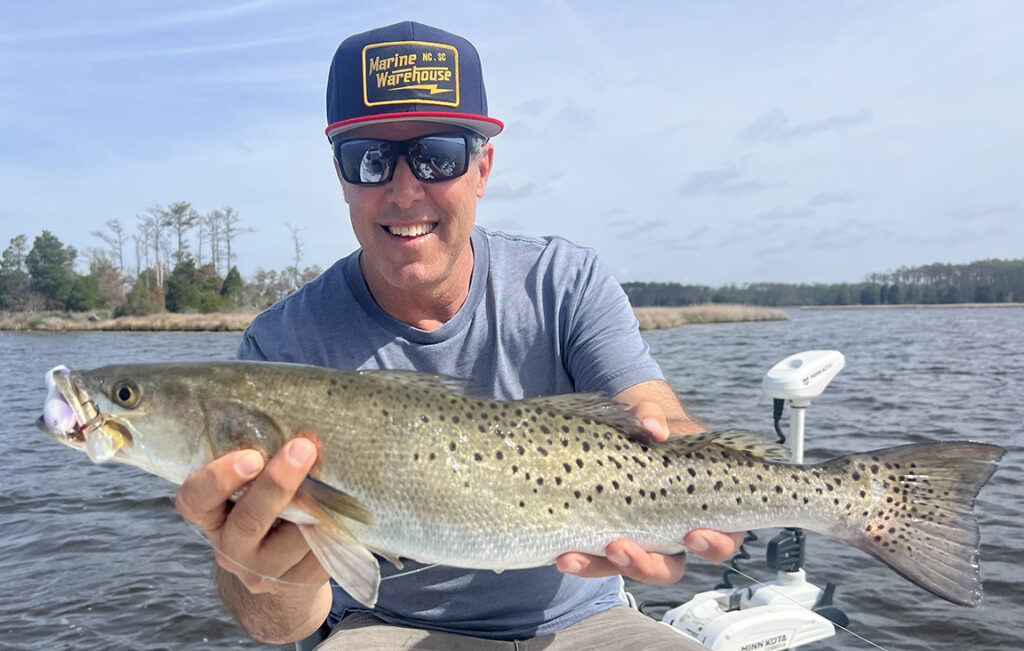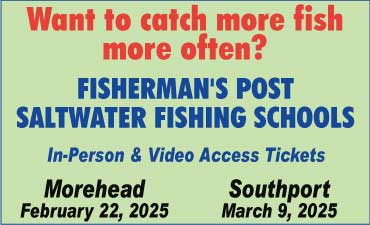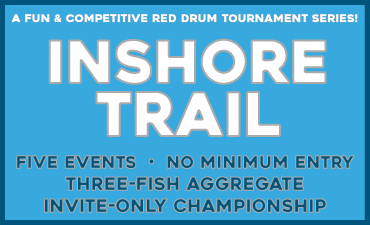Tidelines – May 2025
You may not be able to keep a speckled trout in North Carolina until July, but the guides on the Pamlico and Neuse that I talk to and who are on the water almost every day would like you to know that the fishery is healthy and only showing minimum impact from the winter cold stun event that garnered a lot of attention and led to the closure.
I love keeping and eating speckled trout, as most of us do, but I also enjoy the distinct feeling of a trout thumping my bait and then head shaking its way to the boat, and my fondness for hooking trout, whether I can keep them or not, led me to spend a half day with Capt. Zach Bland, of UFO Charters, who focuses mainly on trout all year long in waters from Belhaven out to Manteo.
April is a transition month for speckled trout, as these fish are moving from the backs of creeks out into bigger water, so Zach’s plan was to meet at the Wrights Creek boat ramp so that we could target areas in the mid to lower Pungo River. For weeks he had been the only one in an area creek holding several schools of quality trout, so we made the relatively short run and focused on a point just inside that creek mouth.
“Fishing in the wind helps orient the boat and orient the fish,” Zach explained as he lowered his PowerPole with the wind at our back and facing a point surrounded by shallow water but with deeper water further off the bank. “The wind can also help get your casts out further, and it creates moving water which is a benefit, too.”
Pamlico waters have wind driven tides, so wind helps Zach predict how the trout will set up to ambush the bait that the wind is pushing to and past the point.

Capt. Zach Bland, of UFO Charters, with a 2+ lb. speckled trout that hit a topwater bait in a creek off of the Pungo River.
Zach gave me three choices of what to throw: a white Berkley Powerbait CullShad, a menhaden-imitation Z-Man Mulletron, or a peanut-shaped topwater with a high pitch rattle and custom painted by Charles Anderson. I could tell that Zach was fond of Charles Anderson and his work, but for me the decision was a topwater with or without Charles.
I threw the topwater where instructed, about 20 yards off the bank, and then gave it my best walk-the-dog retrieve, eager to see a speckled trout blow up on the water’s surface. On my first two casts, I didn’t get that blow up or even a follow, but I did get the attention of Zach who suggested I slow down the speed of the retrieve to try and match the slower cadence of the waves.
It didn’t happen on the first cast or even the second one where I focused on a slower retrieve, but on about the fifth, I could see a trout pushing a little bit of water behind my topwater, and then about halfway between the point and the boat, I came tight to my first topwater speckled trout of the day.
The fish was just shy of three pounds and swam away healthy after a couple of quick photos. I went back to throwing the topwater, and Zach, who loves to throw topwaters just about any time of year and often throughout the day (as opposed to just morning or dusk), continued to share his thoughts on topwaters.
“Lots of people do a steady retrieve, but I like to mix it up and put a pop or a two-pop in there,” he shared. “A harder pop motion will make it splash, and when you’re fishing in wind and waves, the louder presentation often works better to draw fish in.”
Next he shared his thoughts on wind streaks in the water, tracks of bubbles created on the surface when the tops of the waves break and create lines of bubbles.
Zach’s bubble line logic seemed to be sound, but science wasn’t my concern when my second topwater crash happened along one of the bubble lines extending along the port side and continuing on past the point. This fish pulled more drag, felt much heavier on the line, and stayed down deeper and longer. Again we took a couple of quick photos, with this trout weighing 3.9 lbs. on Zach’s handheld scale before being released.
After a few more topwater bites, Zach and I decided to start throwing some soft plastics. The topwater bite was still going strong, even though we were now approaching midday, but for the purposes of the article, we felt compelled to mix it up.
Zach’s soft plastic advice was similar to his topwater advice.
“Slow the retrieve down like you’re fishing a spinner bait—slow enough so you don’t hit the bottom but fast enough so that you can feel the action of the bait,” Zach told me as he handed me the CullShad and grabbed the Mulletron for himself. “In general, you want a steady retrieve with a swim bait. Every now and then, though, you might want to bump it or speed it up or slow it down. If the fish is following behind it, sometimes it takes a different movement than a steady retrieve.”
On our day, the soft plastics produced about equal to the topwaters. Zach and I both enjoyed consistent action, and 90% of our fish were keepers, with a handful in the three-pound class and up, and the majority in the two-pound class.
When I asked about how this spring, following the winter cold stun event, compared to last year’s spring fishery, Zach shared, “In the Pungo, instead of catching four citations in a day, you might only catch one, and the Pamlico River was even less affected. Areas to the north that got more snow and more snow runoff were affected a little more, but overall, the trout population is healthy.”
And that’s the message, in general, that the guides from the Pamlico and Neuse areas that work with Fisherman’s Post have been telling me about the status of speckled trout. The trout are plentiful, active, behaving like normal, and ready to crush a topwater or smack a soft plastic for your enjoyment.
Capt. Zach Bland, of UFO Charters, would love the opportunity to show you firsthand. In the spring, he follows the trout as they move out of the Pungo, into the Pamlico River, past Engelhard and Swanquarter, and into the sound and over to the coast. Then in the summer, he’s in the Manteo area, but in the fall, he follows them back to the Pungo.
You can find out more about Zach’s guide service by visiting www.ufocharters.com or by calling (252) 373-2410.
The fish may change locations, but Zach consistently keeps both topwaters and soft plastics tied on throughout the year. You can wait until July to put some trout in the box, or you can go sooner to enjoy the thump of a trout hitting a swim bait or the surface explosion of a big trout crashing a topwater.






